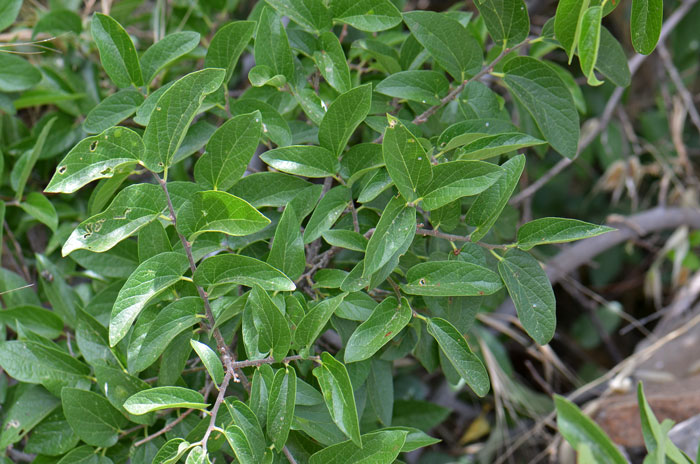 |
 |
Leaves |
|
Description
Celtis reticulata usually grows to a small-sized tree, twenty to thirty feet (6 to 10 m) in height and mature at six to ten inches (15 to 25 cm) in diameter, although some individuals are known up to 70 feet high. It is often scraggly, stunted or even a large bush.[10] It grows at elevations from 500–1,700 metres (1,600–5,600 ft).[9]
Hackberry bark is grey to brownish grey with the trunk bark forming vertical corky ridges that are checkered between the furrows. The young twigs are covered with very fine hairs (puberulent). The blade of the leaves can be half an inch to three inches (2–8 cm) long, usually about two inches (5–6 cm). They are lanceolate to ovate, unequal at the base, leathery, entire to serrate (tending toward serrate), clearly net-veined, base obtuse to more or less cordate, tip obtuse to acuminate, and scabrous, with a dark green upper surface and a yellowish-green lower surface. The small stalks attaching the leaf blade to the stem (the petioles) are generally about 5 to 6 mm long.
The flowers are very small averaging 1/12 of an inch (2 mm) across. They form singly, or in cymose clusters[11] pedicel in fr 4–15 mm. Fruit is a rigid, brownish to purple berry, 5 to 12 mm in diameter, pulp thin.[12][6]
C. reticulata is often confused with the related species Celtis pallida, the spiny hackberry or desert hackberry, Celtis occidentalis, the common hackberry, and Celtis laevigata, the sugarberry or southern hackberry. - Wikipedia
Uses- Food
"The berries and seeds have long been used as a food source by Native Americans of the Southwestern United States, including the Apache (Chiricahua and Mescalero), both fresh and preserved, and the Navajo, who eat them both fresh and ground."- Wikipedia
"Both humans and animals utilize this plant. Native American tribes have eaten the berries from this tree, both fresh and dried (3). Some tribes would roast the berries over a fires, while others would make them into jellies and dried cakes (3). Parts of the tree have been used by native peoples as a source of medicine, fiber, and dye (3). The Papago tribe utilized the bark of the Netleaf Hackberry to craft sandals. The fruits are also a food source for many birds and small mammals." - U of Arizona
Internet Resources
SW Desert Flora |